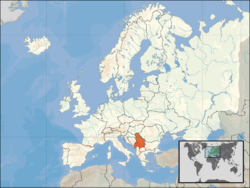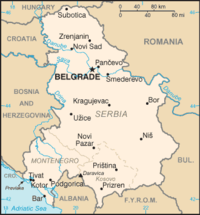Serbia and Montenegro
2007 Schools Wikipedia Selection. Related subjects: Countries; European Countries
|
State union |
|||||
|
|||||
|
|||||
| Capital | Belgrade, Podgorica | ||||
| Language(s) | Serbian | ||||
| Government | Republic | ||||
| President | Svetozar Marović | ||||
| Historical era | Post-Cold War | ||||
| - UN membership¹ | November 1, 2000 | ||||
| - Established | February 4, 2003 | ||||
| - Disestablished | June 5, 2006 | ||||
| Area | |||||
| - 2006 | 102,350 km2 39,518 sq mi |
||||
| Population | |||||
| - 2006 est. | 10,832,545 | ||||
| Density | 105.8 /km² 274.1 /sq mi |
||||
| Currency | Serbian dinar, Euro | ||||
| ¹Membership as FR Yugoslavia ISO 3166-1=CS, ISO 3166-3=CSHH International calling code = 381, UTC offset = +1 |
|||||
Serbia and Montenegro ( Serbian: Србија и Црна Гора / Srbija i Crna Gora, abbreviated as СЦГ / SCG) the State Union [of] Serbia and Montenegro, was a confederated union of Serbia and Montenegro, which existed between 2003 and 2006. The two republics, both of which are former republics of the SFR Yugoslavia, initially formed the Federal Republic of Yugoslavia in 1992. In 2003, the FRY was reconstituted as a State Union Serbia and Montenegro.
On May 21, 2006, Montenegro held a referendum to seek full independence. Final official results indicated on May 31 that 55.5% of voters had elected to become independent. The state union effectively came to an end after Montenegro's formal declaration of independence on June 3, 2006 and Serbia's formal declaration of independence on June 5. Many view this as symbolizing the final end of what was left from the former Yugoslavia.
A loose confederation, Serbia and Montenegro was a union only in certain political areas (e.g. defence). The states had separate economic policies and currencies. The country did not have a unified capital, dividing its common institutions between Belgrade in Serbia and Podgorica in Montenegro.
History
In 2002, Serbia and Montenegro came to a new agreement regarding continued co-operation, which, among other changes, promised the end of the name Yugoslavia, since they were part of the Federal Republic of Yugoslavia. On February 4, 2003, the federal parliament of Yugoslavia created a loose confederation - State Union of Serbia and Montenegro. A new Constitutional Charter was agreed to provide a framework for the governance of the country.
On Sunday, 21 May 2006, Montenegrins voted on an independence referendum, with 55.5% supporting independence. Fifty-five percent or more of affirmative votes were needed to dissolve the state union of Serbia and Montenegro. The turnout was 86.3% and 99.73% of the more than 477,000 votes cast were deemed valid.
The subsequent Montenegrin proclamation of independence on June 3, 2006 and the Serbian proclamation of independence on June 5 ended the State Union of Serbia and Montenegro and thus the last remaining vestiges of the former Yugoslavia.
Administrative divisions
Serbia and Montenegro was composed of two republics. Serbia, meanwhile, had two subordinate autonomous provinces. The structure of Serbia and Montenegro:
- Serbia (capital: Belgrade)
- Vojvodina – autonomous province within Serbia (capital: Novi Sad)
- Kosovo and Metohia – autonomous province under United Nations administration (capital: Priština)
- Montenegro (capital: Podgorica)
The country's political and administrative capital was Belgrade, while its judicial capital was Podgorica.
Geography
Serbia and Montenegro had an area of 102,350 square kilometres (39,518 sq mi), with 199 kilometres (124 mi) of coastline. The terrain of the two republics is extremely varied, with much of Serbia comprising plains and low hills (except in the more mountainous region of Kosovo) and much of Montenegro consisting of high mountains. Serbia is entirely landlocked, with the coastline belonging to Montenegro, which also possessed the only fjord in southern Europe. The climate is similarly varied. The north has a continental climate (cold winters and hot summers); the central region has a combination of a continental and Mediterranean climate; the south enjoyed an Adriatic climate along the coast, with inland regions experiencing hot, dry summers and autumns and relatively cold winters with heavy snowfall inland.
Belgrade, with its population of 1,574,050, is the largest city in the two nations: and the only one of significant size. The country's other principal cities were Novi Sad, Niš, Kragujevac, Podgorica, Subotica, Priština, and Prizren, each with populations of about 100,000-250,000 people.
Demographics
Serbia and Montenegro had more demographic variety than most other European countries. The three largest named nationalities were Serbs (62.3%), Albanians (mostly Ghegs) (16.6%) and Montenegrins (5%) according to the 1991 census. The country also had significant populations of Hungarians, Roma, Bulgarians, Ethnic Macedonians, Romanians and other eastern Romance peoples (including Aromanians, Megleno-Romanians and Vlachs), and dozens of other Slavic denominations, namely Bosniaks, Croats, Bunjevci, Šokci, Goranci, Janjevci, Rusins, Slovaks, Muslims by nationality and Yugoslavs. Turkic subgroups still live in Kosovo (mostly Gagauz and Seljuks). There were a number of citizens who declared their nationality as Egyptian and Ashkali. These two were previously regarded as a part of Roma who are of the belief that they originated from present-day Egypt and Israel. Most of the ethnic diversity was situated in the provinces of Kosovo and Vojvodina, where smaller numbers of other minority groups may have be found. The large Albanian population was chiefly concentrated in Kosovo, with smaller populations in the Preševo and Bujanovac municipalities in Central Serbia, and in the south-east of Montenegro ( Ulcinj municipality). The large Bosniak population lived in the Sandžak region on the border between Serbia and Montenegro.
- Total Serbia-Montenegro - 10,019,657
- Serbia (total): 9,396,411
- Vojvodina: 2,116,725
- Central Serbia: 5,479,686
- Kosovo: 1,800,000
- Montenegro: 623,246
- Major cities (over 100,000 inhabitants) - 2002 data (2003 for Podgorica):
- Beograd (Belgrade): 1,280,639 (1,574,050 metro)
- Novi Sad: 215,600 (298,139 metro)
- Priština: 200,000 (2002 estimation)
- Niš: 173,390 (234,863 metro)
- Kragujevac: 145,890 (175,182 metro)
- Podgorica: 139,500 (169,000 metro)
- Prizren: 121,000 (2002 estimation)
- Subotica: 99,471 (147,758 metro)
According to an estimate from 2004, the State Union had 10,825,900 inhabitants.
According to a July of 2006 estimate, the State Union had 10,832,545 inhabitants.
Economy
Mismanagement of the economy, an extended period of economic sanctions, and the damage to Yugoslavia's infrastructure and industry caused by the Kosovo War left the economy only half the size it was in 1990. Since the ousting of former Federal Yugoslav President Slobodan Milošević in October 2000, the Democratic Opposition of Serbia (DOS) coalition government has implemented stabilization measures and embarked on an aggressive market reform program. After renewing its membership in the International Monetary Fund in December 2000, Yugoslavia continued to reintegrate into the international community by rejoining the World Bank (IBRD) and the European Bank for Reconstruction and Development (EBRD). A World Bank- European Commission sponsored Donors' Conference held in June 2001 raised $1.3 billion for economic restructuring. An agreement rescheduling the country's $4.5 billion Paris Club government debts was concluded in November 2001; it will write off 66% of the debt; a similar debt relief agreement on its $2.8 billion London Club commercial debt has been reached in July 2004; 62% of the debt have been written off.
The smaller republic of Montenegro severed its economy from federal control and from Serbia during the Milošević era. During the Serbia and Montenegro period, both republics had separate central banks, different currencies - Montenegro used the euro, while Serbia used the Serbian dinar as official currency. The two states also had different customs tariffs, separate state budgets, police forces, governments.
The southern Serbian province of Kosovo, while formally still part of Serbia (according to United Nations Security Council Resolution 1244), moved toward local autonomy under the United Nations Interim Administration Mission in Kosovo ( UNMIK) and was dependent on the international community for financial and technical assistance. The euro and the Yugoslav dinar were official currencies, and UNMIK collected taxes and managed the budget.
The complexity of Serbia and Montenegro's political relationships, slow progress in privatisation, and stagnation in the European economy were detrimental to the economy. Arrangements with the IMF, especially requirements for fiscal discipline, were an important element in policy formation. Severe unemployment was a key political economic problem. Corruption also presented a major problem, with a large black market and a high degree of criminal involvement in the formal economy.
Transportation
Serbia, and in particular the valley of the Morava is often described as "the crossroads between the East and the West" - one of the primary reasons for its turbulent history. The valley is by far the easiest way of land travel from continental Europe to Greece and Asia Minor.
Until the outbreak of the Yugoslav wars, the ironically-named highway "Bratstvo i jedinstvo" (Brotherhood and Unity) running through Croatia, Serbia and FYRO Macedonia was one of Europe's most important transport arteries. It gradually resumed this role as the security situation stabilized.
Major international highways going through Serbia are E75 and E70. E763/ E761 is the most important route connecting Serbia with Montenegro.
The Danube, an important international waterway, flows through Serbia.
The largest seaport is Montenegro's Bar.
Holidays in Serbia and Montenegro
| Date | Name | Notes |
|---|---|---|
| January 1 | New Year's Day | (non-working holiday) |
| January 7 | Orthodox Christmas | (non-working) |
| January 14 | National Holiday (Serbian New Year) | Српска Нова година Srpska Nova godina |
| January 27 | Saint Sava's feast Day — Day of Spirituality | |
| April 27 | Constitution Day | |
| April 29 | Orthodox Good Friday | Date for 2005 only |
| May 1 | Orthodox Easter | Date for 2005 only |
| May 2 | Orthodox Easter Monday | Date for 2005 only |
| May 1 | Labour Day | (non-working) |
| May 9 | Victory Day | |
| June 28 | Vidovdan ( Martyr's Day) | In memory of soldiers fallen at the Battle of Kosovo |
- Holidays celebrated only in Serbia
- February 15 - Sretenje ( National Day, non-working)
- Holidays celebrated only in Montenegro
- July 13 - Statehood Day (non-working)



